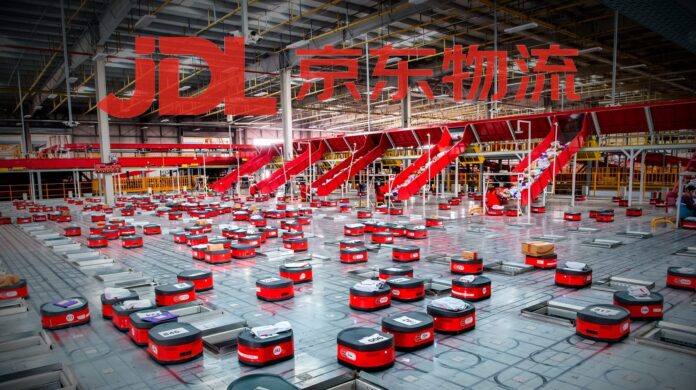The smart logistics operation at China-based retail giant JD.com “makes Amazon look primitive”, reckons regional English-language title The Asia Times. Certainly, its warehousing and fulfilment business, JD Logistics (JDL), caught the attention of the industrial tech media this summer when it revealed a fleet of 100-odd 5G-connected automated guided vehicles (AGVs) had steered it through its (self-created) busy ‘6/18’ (June 18) sales rush in China.
Efficiency – of goods in transit – was up 200 percent, it claimed. JDL has been managing the new 5G network, rendered as a private installation on local blocks of public spectrum, at a distribution centre in Changsha, in the Hunan province in southern China, billed as the company’s busiest logistics park (called “Changsha Asia No.1”). At the time, it was an “industry-first” for a “scaled commercial deployment of [a] private 5G smart warehouse”, it said.
The lightbulb moment for JDL, like for others, has been to “resolve AGV heartbeat abnormality”. AGVs connected to 5G maintain close to zero packet loss, it said, with connection timeouts dropping by 70 percent compared to Wi-Fi. Use cases on the network are being multiplied, too, to include machine vision for quality control and IoT tracking for traceability. Shenzhen-based AI-LINK is the only vendor to be name-dropped, on the record, but most local vendor and operator familiars are engaged variously as well.

In conversation with Enterprise IoT Insights, Yami Chen, 5G expert at JDL, says the project has been multiplied-out to other warehouse sites in China, already. How many? Chen provides a number, and then withdraws it. But suffice to say it is a decent double-digit count – which puts yesterday’s Airbus headline about the preeminence of the European firm’s multi-site private LTE/5G rollout in some kind of perspective.
Except that Chen also says its own expansion is “pre-scale”, and asks for the number to be spiked from the copy. But the number of networks is not that important (and we are just glad to have the call); what is more interesting is the revelation that JDL has developed a whole logistics-network management system to go with these private 5G installations, which it will sell globally as part of an Industry 4.0 bundle, with and without private 5G vendors.
Which, of course, on paper, describes the ultimate promise of digital change for enterprises – not just higher efficiency and production, but total reinvention, or at least new revenue.
“We want to be a customer and a vendor of 5G applications for logistics,” says Chen. A further point about these named and unnamed vendors; JDL is working with the whole telecoms ecosystem, she says, including these other China brands, to optimise telecoms for logistics and logistics for telecoms – to raise network performance for logistics apps, reduce network costs for logistics companies, and go mob-handed to market to popularise industrial-type 5G.
But, Chen can tell you all of this herself, and much more. “For private 5G to scale in the logistics industry, costs need to come down – in line with LTE and Wi-Fi costs,” she says. “And cooperation is required to achieve that. We are committed to work with the telecoms industry to showcase the value of 5G systems, and to raise interest in them from the wider logistics industry.” A transcript of the conversation is included below; all answers are from her.

Talk about what you are doing with 5G, and the strategy?
“We have deployed private 5G to connect AGVs at warehouses – specifically to stop the previous problem of abnormal timeouts, caused by delays on Wi-Fi networks. It has delivered operational stability to the AGV fleet – which has, in turn, improved processing capabilities and overall warehouse efficiency, which has helped particularly during peak sales periods, like the 6/18 sales promotion. 5G affords zero packet loss, unlike Wi-Fi; it has lowered AGV timeouts by over 90 percent.
“You would require more than 10 Wi-Fi access points to connect AGVs across a warehouse of 5,000-7,000 square meters, for example, handovers between Wi-Fi access points could be frequent alongside possible connection failures; so provided there is enough floor space with a large-scale AGV cluster, and a requirement for real-time control of AGVs, then 5G is the ideal way to guarantee performance. During the 6/18 promotion, we had over 100 AGVs connected to 5G in our warehouses – and the network timeouts to the AGV-fleet reduced by over 90 percent.
“Not only the smart logistics platform, we have also developed a 5G logistics management system platform, which gives the health status of the network and all the devices on it – so, in the case of AGVs, we can develop the maintenance schedule, and see if there are any issues in the network itself. JD Logistics is also using private 5G for intelligent storage, traceability, and security in warehouse environments, using IoT, AI, AR applications – all managed from within our smart logistics platform and 5G management platform.
“Network performance is monitored and guaranteed, and warehouse management efficiency and safety has been greatly improved. As a result – and the need for human intervention has dramatically reduced. And we are integrating into the transport and distribution side, as well – for intelligent delivery services. Our view is that 5G will be an essential information infrastructure for the logistics industry, and more widely, just like cloud computing. Our strategy, with our logistics platform, is to drive efficiency in the whole supply chain, in our own operations and in customers’ operations, in China, and also abroad.”
What spectrum are you using and who owns it? Does it belong to an operator, or is it your own spectrum?
“In China, we mostly work directly with network operators. The spectrum is public, licensed to the operator, but the network in the warehouse can be private, for use only by JD Logistics. We cooperate with different 5G operators. We use spectrum at 2.6 GHz, and also at 3.3 GHz, 3.4 GHz, and 3.5 GHz – to serve our warehouses, and our logistics partners. At the same time, we are working with the equipment vendors to develop further network and service synergies, and also to expand our business proposition overseas, including in different local 5G spectrum bands.”
Has JD Logistics installed RAN infrastructure from Huawei and ZTE in its warehouses?
“We are quite open with the vendors. We want to work with the most advanced technologies. We are cooperating with AI-LINK, for example, to reduce network costs. But we are cooperating with others, too, because different of them have different advantages. We need to provide the best service, based on the best technologies.”
At how many sites have you deployed private 5G? You have this big warehouse in Changsha, in Hunan; do you have others, also equipped with 5G networks?
“We deployed 5G-based applications in Beijing first, where our R&D teams are based. So we started there, in 2019, which was, in fact, the first logistics park in China to use 5G. We are now using private 5G for logistics applications in other warehouses across China, as well. But we are still in a pre-scale period.”
What are the challenges to scale this? What is the process to make this a standard technology within all of your sites?
“It requires the whole ecosystem to cooperate. JD Logistics is committed to be a leading provider of technology solutions for the logistics industry. We want to provide customers with more efficient logistics services, and to reduce logistics costs. For private 5G to scale as a network solution in the logistics industry, costs need to come down further – in line with LTE and Wi-Fi costs. And cooperation is required to achieve that. We are committed to work with the telecoms industry to showcase the value of 5G systems, and to raise interest in them from the wider logistics industry. Because the market has to understand what they are buying, and why they are buying it – the value they will get back on their investments. And our 5G-based solutions very clearly demonstrate value.
“Our work with the 5G vendors and operators is based on three principles. The first objective is to improve each other’s respective capabilities. Because 5G improves our own business capabilities, by reducing things like AGV timeouts and improving overall warehouse efficiency, and our collaboration demonstrates the value of 5G to industry. The second thing is the commercial aspect to this symbiotic relationship; so we have developed joint-5G logistics solutions with vendors that we are promoting together, via each other’s sales channels.
“The third element is our joint work to improve the 5G performance and costs. Our 5G logistics management system, for example, connects with equipment from any 5G vendor, and provides end-to-end system visibility, to make the network, as well as the applications and equipment on it, more manageable and effective – to maximise the investment. A 5G module costs more than 2,000 RMB at the moment. But we are exploring how RedCap, say, will offer enough performance to sustain certain logistics services, while also reducing the cost of 5G hardware. So our cooperation with the industry is quite broad.”
Is JD Logistics managing its own 5G networks at its own sites, on its own – via this end-to-end management platform? Or is the operator of the vendor managing your 5G networks?
“We have cooperated with the vendors and operators to build this 5G management system. They provide live data about the network performance to the platform. So from the 5G management system, I can see where the problem is – it could be the device, the AGV, or the network itself, or the service host. So, with this end-to-end visibility, we can quickly decide where the problem goes, and quickly resolve it.”
Do some use logistics cases work fine with LTE? Presumably some warehouse work remains on Wi-Fi, too – and some with LTE, 5G, NB-IoT? Are you using all of these technologies?
“Yes. We previously used Wi-Fi in lots of mobile applications in the warehouse – and public 4G out on the road, in our vehicle locator positioning devices, for example, along with satellite and Wi-Fi.”
So is the big plan to export the 5G network management platform and 5G-based logistics applications to other logistics companies? Is that correct – that you want to be a logistics-technology vendor, as well?
“Yes. We want to be a customer and a vendor of 5G applications for logistics. On the one hand we are a customer for these things, and on the other we are working with both the telecoms and warehousing sectors to serve the wider logistics industry, including not only the logistics companies, but also the customers who require logistics services.”
How much of the JD Logistics business serves JD.com, and how much provides fulfilment services for other industries and companies?
“More than 60 percent of JD Logistics’ revenues come from the outside industry – not from JD.com. We have customers in different industries, which all need logistics services – like the car industry, medical industry, electronics industry, and FMCG industry. We serve different industries.”
You said earlier that JD Logistics is working with telecoms vendors to look at other markets, outside China – to see what the spectrum situation is, and to see how to go to market. Does JD Logistics have warehouses across the globe, already, or is it primarily interested in serving the rest of the global supply chain?
“Yes, we are looking to sell 5G solutions for the logistics industry at home and abroad. Our ultimate goal is to help customers to improve their efficiencies and costs. And 5G provides a networking platform to do that, and to launch all kinds of new logistics applications that do the same. But we can work with Wi-Fi based solutions, as well. It is not just about 5G.”
How do you think China is doing with private 5G / Industry 4.0 – versus the rest of the world? Because it is a different market. Many markets are now allocating spectrum directly to enterprises; but in China, spectrum is very much still owned and controlled by operators. So it is a slightly different 5G profile for industry. How do you see industrial 5G developing in China, versus everywhere else?
“Different countries have different situations because of different circumstances. Public 5G may not be so well deployed in some countries, perhaps – whereas, in China, 5G is available all over the country, which means lots of opportunities to access 5G networks. But for us, we are more interested in developing the applications [than selling networks], and we think we can be relevant to supply chain customers whatever their situation with local 5G spectrum. We are committed to our goal – to develop 5G-based logistics solutions to drive efficiency and intelligence for customers.”
How much is JD Logistics working to supply IoT tracking and monitoring solutions outside of the warehouse – on the road, between the warehouse and the manufacturer and the retailer, for example? Is JD Logistics working on solutions for those types of applications, to track goods with the public mobile networks?
“Yes, of course. Our goal is to provide end-to-end logistics technologies and services, and the end-to-end visibility across the supply chain. We were the first logistics hub in China to deploy 5G, and we have started to scale this 5G AGV application, but these are just part of the story. We have trucks and delivery cars on the road all the time, connecting to cellular to get visibility of vehicle loads in transit, and to integrate with logistics processes – and not just cellular, but RFID for commodity identification and satellite for positioning, and so on. So we use different technologies to achieve supply chain visibility.”

